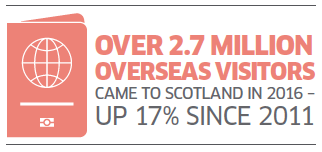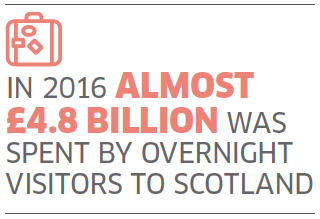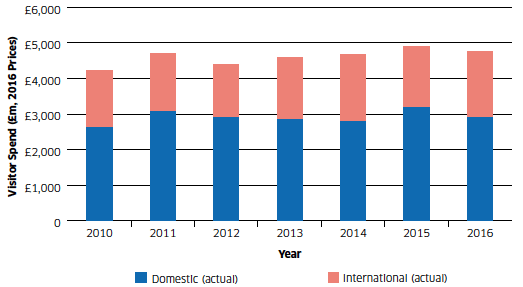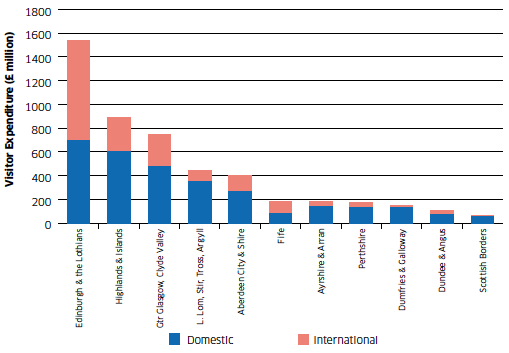Tourism in Scotland: the economic contribution of the sector
A report commissioned by the Tourism Leadership Group setting out economic data and trends on tourism across Scotland.
Chapter 2: The Value of Visitors to Scotland [4]

Young travellers at Pittenweem Harbour, Kingdom of Fife.
2.1. As a long-established, mature destination, Scotland has been a popular choice for visitors from the UK and Europe for decades.
2.2. In recent years, tourism has become one of the fastest growing economic sectors in the world. Inbound tourist arrivals (overnight visitors) grew to over 1.2 billion in 2016, an increase of 46 million (3.9 per cent) on the previous year. International tourist arrivals worldwide are forecast to increase by 3.3 per cent a year between 2010 and 2030 to reach 1.8 billion by 2030 [5] .
2.3. The UK ranks highly in terms of global tourism destinations, being 8th in the world for international tourist arrivals (34.4 million) and 5th for tourism receipts ( US$ 45.5 billion) [6] . Although London receives over half of international visitor numbers and spend within the UK, Scotland also generates a substantial portion of the UK’s attraction, with 7 per cent of international trips to UK and 8 per cent of spend [7] .
Infographic:

Infographic Text:
Over 2.7 Million Overseas Visitors Came To Scotland In 2016 – Up 17% Since 2011
Visitors to Scotland
2.4. Tourism in Scotland includes overnight visitors from other parts of Scotland, the rest of the UK, or from overseas. It also includes people making day visits to different parts of Scotland, either from other parts of Scotland or across the UK.
2.5. In 2016, there were almost 14.3 million overnight visitors to Scotland. Visitors from across Great Britain represent the majority of overnight visitors to Scotland. In 2016, there were around 11.5 million overnight visits from across Great Britain, and a further 2.7 million from overseas. There were also 142 million day visits within Scotland in 2016 [8] .
2.6. In recent years, there have been divergent trends within the different sections of the overnight visit market in Scotland. Between 2011 and 2016, total overnight visitor numbers declined by around 9 per cent. This decline in overnight visitor numbers has been driven by visitors from within Great Britain, whose numbers declined by 14 per cent between 2011 and 2016.
2.7. However, over the same period, overseas visitor numbers have increased significantly: between 2011 and 2016, numbers of overseas visitors increased by 17 per cent. Within these, the USA, Germany and France have been the main sources of overseas visitors to Scotland, accounting for over one third of total visitors in 2016.
2.8. Growth in visitor numbers from the USA and Germany have been the drivers of growth in Scotland’s international visitor numbers, as is highlighted by Table 1 on page 9.
Table 1: International Visitors to Scotland, Selected countries, 2011-2016 (thousands)
| 2011 | 2012 | 2013 | 2014 | 2015 | 2016 | Growth, 2011-16 | |
|---|---|---|---|---|---|---|---|
| USA | 333 | 324 | 316 | 417 | 409 | 451 | 36% |
| Germany | 250 | 281 | 293 | 343 | 323 | 355 | 42% |
| France | 169 | 174 | 193 | 191 | 196 | 152 | -10% |
| Canada | 103 | 90 | 106 | 122 | 98 | 149 | 44% |
| Poland | 57 | 67 | 80 | 138 | 87 | 138 | 143% |
| Australia | 130 | 127 | 138 | 158 | 142 | 132 | 1% |
| Italy | 86 | 99 | 100 | 67 | 92 | 123 | 43% |
| Netherlands | 131 | 150 | 138 | 149 | 157 | 115 | -13% |
| Irish Republic | 195 | 149 | 105 | 113 | 78 | 96 | -51% |
| Spain | 132 | 114 | 93 | 101 | 146 | 89 | -33% |
| Total International Visitors | 2,350 | 2,225 | 2,421 | 2,700 | 2,592 | 2,747 | 17% |
Source: ONS (2017), International Passenger Survey
2.9. There are also differences between durations of visit between overnight visitors from Great Britain and overseas. The average length of trip for a domestic overnight visitor in 2016 was between 3 and 4 days. Around 38 per cent of overseas visitors stayed for between 4 and 7 nights, while 44 per cent of overseas visitors stayed for longer than this.
2.10. People visit Scotland for a variety of reasons. However, the majority of overnight visitors to Scotland are on holiday. Table 2 below sets out the different shares of overnight visitors by reasons for their stay.
Table 2: Overnight Trips to Scotland, by Reason for Stay [9]
| Scotland Residents | Rest of GB | Overseas | ||||
|---|---|---|---|---|---|---|
| Volume (000’s) | Share (%) | Volume (000’s) | Share (%) | Volume (000’s) | Share (%) | |
| Holiday | 3,354 | 57% | 3,010 | 49% | 1,471 | 54% |
| Visiting Friends & Relations | 1,710 | 29% | 1,751 | 28% | 782 | 28% |
| Business | 590 | 10% | 1,141 | 19% | 413 | 15% |
| Other | 188 | 3% | 244 | 4% | 81 | 3% |
| Total | 5,842 | 100% | 6,146 | 100% | 2,747 | 100% |
Source: ONS (2017), Great Britain Tourism Survey, International Passenger Survey
2.11. Edinburgh is the most popular location for trips in Scotland, both for visitors from within Scotland, Great Britain and from overseas. In 2016, Edinburgh and the Lothians was the destination for 42 per cent of overseas visitors’ overnight trips, followed by Greater Glasgow and Clyde Valley (18 per cent) and Highlands and Islands (14 per cent).
2.12. cotland has a number of popular visitor attractions. Both the National Museum of Scotland and Edinburgh Castle exceeded 2 million visitors in 2017, making them the most visited attractions outside of London [10] . Box 1 below gives an overview of recent trends in Scotland’s visitor attractions.
Box 1: Visitor Attractions in Scotland
Scotland has a varied and diverse range of visitor attractions across the length and breadth of the country. These include UNESCO World Heritage sites; iconic, world-renowned historical attractions like Edinburgh Castle; important wildlife and natural heritage attractions; cutting-edge cultural attractions; and those that showcase Scotland’s status as the home of both golf and whisky. Scotland’s diverse visitor attractions make an important contribution to Scotland’s tourism sector.
Table B1 gives details of the most popular attractions across Scotland:
Table B1: Most Visited Attractions in Scotland, 2017
| Paid Attractions | Free Attractions | ||
|---|---|---|---|
| Attraction | Visitor Numbers |
Attraction | Visitor Numbers |
| 1 Edinburgh Castle | 2,063,709 | 1 National Museum of Scotland | 2,165,601 |
| 2 Edinburgh Bus Tours | 690,082 | 2 Scottish National Gallery | 1,600,761 |
| 3 Stirling Castle | 567,259 | 3 Riverside Museum | 1,355,359 |
| 4 Edinburgh Zoo | 519,281 | 4 Kelvingrove Art Gallery & Museum | 1,304,072 |
| 5 Urquhart Castle | 488,136 | 5 St Giles’ Cathedral | 1,285,654 |
| 6 Glasgow Science Centre | 425,961 | 6 Royal Botanic Garden Edinburgh | 821,955 |
| 7 Glenfinnan Monument | 396,448 | 7 Gretna Green Famous Blacksmith's Shop | 812,177 |
| 8 Royal Yacht Britannia | 390,482 | 8 National War Museum | 764,079 |
| 9 The Scotch Whisky Experience | 376,757 | 9 Regimental Museum of the Royal Scots Dragoon Guards | 745,208 |
| 10 Loch Ness by Jacobite | 298,000 | 10 Gallery of Modern Art | 670,555 |
Source: Moffat Centre (2018), Scottish Visitor Attraction Monitor 2017
Data from the Moffat Centre also suggests that in 2017, visitor attractions in Scotland experienced a 7.0 per cent increase in visitor numbers compared to 2016.
Attractions in Greater Glasgow and the Clyde Valley and Edinburgh and the Lothians received the greatest number of visitors (almost 21 million and over 17 million respectively), while substantial growth in visits were seen in attractions in areas like Aberdeen & Grampian (up over 13 per cent) and Orkney (up 14 per cent). Outdoor and Nature Attractions and Museums and Art Galleries were the most popular types of attraction (with around 21 million and over 17 million visitors respectively) while substantial growth was seen in visits to Castles/Forts (up 21 per cent to around 5.3 million visitors) and Distilleries, Breweries and Wineries (up over 13 per cent to around 1.7 million visitors). These give an indication of the diverse range of attractions that Scotland has to offer.
Expenditure by Visitors to Scotland
2.13. In 2016, expenditure by visitors to Scotland was valued at around £9.7 billion [11] . Of this, almost half (£4.75 billion) was generated by overnight visitors. Around 61 per cent of overnight expenditure was generated by UK visitors, while around 39 per cent was generated by overseas visitors.
2.14. ince 2011, total visitor spend has increased by 9 per cent in nominal terms, or 1 per cent in real terms, largely driven by a 24 per cent increase in international visitor spend in nominal terms and a 1 per cent increase in spend by UK overnight visitors in nominal terms [12] . Chart 1 below shows the domestic and international spend since 2010.
2.15. Visitors from the USA were responsible for almost £510 million of overseas’ visitors expenditure in 2016 – 28 per cent of the total. Germany (£212 million), Canada (£130 million), Australia
(£102 million) and Italy (£92 million) were the other countries in Scotland’s top 5 markets in terms of expenditure in 2016.
2.16. Table 3 overleaf shows the total visitor spend, number of trips and average spend per trip for 2016. While 61 per cent of spend is generated by UK visitors, they account for 81 per cent of the trips. International visitors account for 19 per cent of trips and 39 per cent of spend.
Infographic:

Infographic Text:
In 2016 Almost £4.8 Billion Was Spent By Overnight Visitors To Scotland
Chart 1: International and Domestic Overnight Visitor Spend from 2010 - 2016 (£m, Real Terms)

Sources: ONS (2017), Great Britain Tourism Survey, International Passenger Survey
Table 3: Total Overnight Visitor Spend, Number of Trips and Average Spend in 2016
| Overnight Visitors | Total Spend (£ million) | Trips (million) | Average Spend/Trip |
|---|---|---|---|
| UK visitors | £2,897 | 11.51 | £252 |
| International visitors | £1,850 | 2.75 | £673 |
| All visitors | £4,747 | 14.26 | £333 |
Sources: ONS (2017) Great Britain Tourism Survey, International Passenger Survey
Chart 2: Overnight Visitor Spend (Domestic & International) by Region (2016) [13]

Source: ONS, Great Britain Tourism Survey, International Passenger Survey
2.17. Chart 2 shows that Edinburgh and the Lothians receive almost one third of all overnight visitor expenditure (32 per cent). Highlands and Islands received 18 per cent of expenditure, while Glasgow received 15 per cent.
2.18. This data helps to illustrate the importance of tourism to both Scotland’s regions, and Scotland as a whole.
Summary
2.19. In recent years, while overall numbers of overnight visitors to Scotland have fallen, numbers of overseas visitors have increased substantially, as has the value of expenditure by visitors to Scotland. While Edinburgh and the Lothians receive the largest shares of both visitor numbers and expenditure, overall visitor numbers and expenditure are distributed widely across Scotland. This supports a sector that operates across Scotland, the characteristics of which are described in Chapter 3.
Contact
There is a problem
Thanks for your feedback